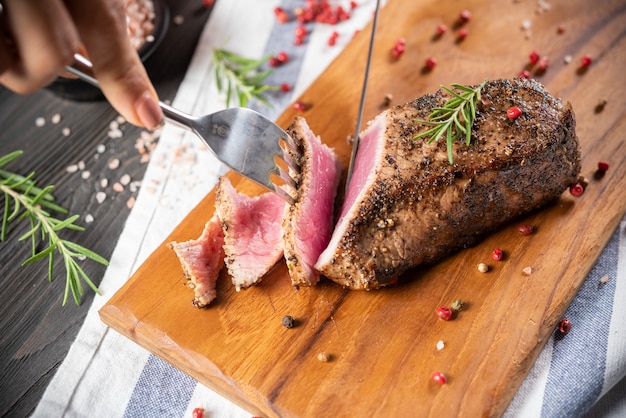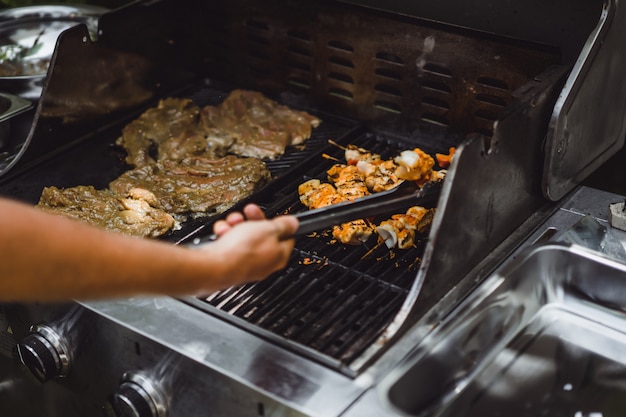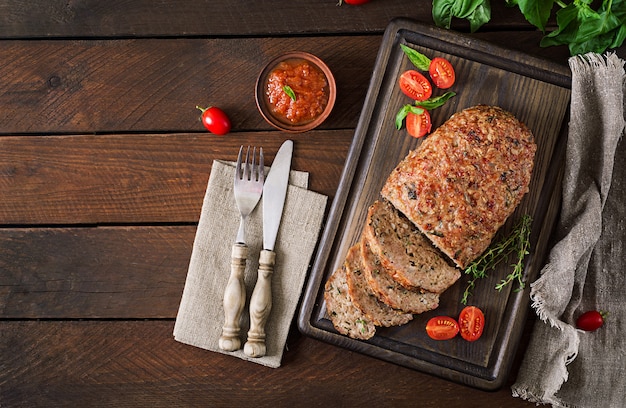(Part 1) The Prime Cuts: Choosing Your Steak

beef cuts for Oven Baking:
- Rib-eye: This is the king of steaks, and for good reason. The marbling – those streaks of fat running through the meat – is what makes it so incredibly flavorful and tender. It melts in your mouth, creating a luxurious dining experience. Rib-eye is the ideal cut for a steak that's meant to be savored.
- new york strip: A bit leaner than the Rib-eye, but no less delicious. New York Strip has a robust flavor profile and a wonderful texture, making it perfect for both grilling and oven baking. I personally love to marinate this cut overnight for even more intense flavor.
- Sirloin: A versatile and affordable choice, Sirloin offers a good balance of flavor and tenderness. It's a great option if you're looking for a leaner cut, and it holds its shape well, making it ideal for thinner steaks.
- filet mignon: This is the ultimate indulgence. Filet mignon is known for its unparalleled tenderness and buttery texture. Being lean, it requires careful cooking to avoid overdoing it. Save this for special occasions, when you want to impress your guests with the very best.
Thickness Matters:
Here's a crucial tip: don't settle for anything less than 1.5 inches thick. This ensures a beautiful sear on the outside while keeping the interior perfectly juicy. Anything thinner risks becoming dry and tough, which is a steak tragedy.(Part 2) Getting Ready to Bake: Preparing the Steak

Pat It Dry:
This step is often overlooked, but it's essential for a flawless sear. Pat the steak dry with paper towels to remove any excess moisture. Water creates steam, which hinders the browning process. We want that crisp, caramelized crust, and dry meat is the key!Seasoning Up:
This is your chance to unleash your inner chef! Salt and pepper are the fundamental building blocks, but don't be afraid to get creative. I love experimenting with garlic powder, onion powder, and a touch of smoked paprika for a smoky depth. Herbs like rosemary or thyme can add an earthy complexity.The Sear: That Essential Crust
This is where the magic happens. A perfectly seared steak is a work of art, showcasing a beautiful, caramelized crust that encapsulates the juicy meat within. Get your skillet ripping hot: I swear by a cast-iron skillet. It heats up quickly and evenly, creating the perfect environment for searing. Treat it like a personal pizza oven for your steak! Add the oil: Once the skillet is screaming hot, add a tablespoon or two of oil. Use a high-heat oil like avocado or grapeseed – they won't smoke easily. Carefully place your steak: Once the oil is shimmering, gently place your steak in the skillet. Be careful, it's hot! Don't touch it!: Let the steak cook undisturbed for 3-4 minutes per side. Patience is key here. You're building that gorgeous crust, so resist the temptation to move it around too early.(Part 3) Baking for Perfection

The Oven Setup
Pre-heat your oven to 400 degrees Fahrenheit (200 degrees Celsius). Now, I'm a firm believer in cooking by feel, but a meat thermometer can be a helpful tool, especially if you're still getting comfortable with different levels of doneness.Bake Time:
The baking time depends on the thickness of your steak and your preferred level of doneness. For a medium-rare steak, I usually bake it for about 8-10 minutes. For medium, it's around 12-14 minutes.Resting Time:
This is crucial! After you take your steak out of the oven, let it rest for at least 5-10 minutes before slicing. This allows the juices to redistribute throughout the meat, creating a more tender and juicy steak. It's a simple step, but it makes a world of difference in the final result.(Part 4) The Art of Judging Doneness
We're aiming for that perfect medium-rare, the holy grail of steak cookery. But how do you know when it's reached that glorious state? Here's a guide to help you navigate the different levels of doneness:Doneness Guide:
| Doneness | internal temperature (°F) | Internal Temperature (°C) | Steak Appearance |
|---|---|---|---|
| Rare | 125-130 | 52-54 | Center is red, cool to the touch |
| Medium-Rare | 130-135 | 54-57 | Center is mostly red, slightly warm to the touch |
| Medium | 135-140 | 57-60 | Center is pink, warm to the touch |
| Medium-Well | 140-145 | 60-63 | Center is slightly pink, hot to the touch |
| Well Done | 145-150 | 63-66 | Center is brown, very hot to the touch |
The Touch Test:
Rare: The center will be cool and soft to the touch. Medium-Rare: The center will be slightly warm and feel a bit springy. Medium: The center will be warm and feel firmer.Visual Clues:
Rare: The steak will be red throughout. Medium-Rare: The steak will have a slightly pink center. Medium: The center will be pink, with a slight brown ring around the edges.(Part 5) Mastering the Sauces: Elevating Your Steak
Your steak is perfectly cooked, but now it's time to add that final touch of magic – a delicious sauce! The right sauce can truly elevate your steak to a whole new level of flavor.The Simple Classics:
Butter and Herbs: This is a timeless classic for a reason. Simply melt some butter in a saucepan and add a few sprigs of fresh herbs like thyme or rosemary. The aroma alone is enough to entice your taste buds. This sauce adds a subtle richness and an elegant touch. Red Wine Sauce: For a more robust and sophisticated flavor profile, a red wine sauce is a perfect match. A little red wine, beef stock, and some herbs simmered together create a deeply flavorful sauce that complements the richness of the steak.Creative Combinations:
Gorgonzola Cream Sauce: If you enjoy a bit of a pungent kick, this sauce is for you. The creamy texture and bold cheese flavor create a unique and irresistible topping. It's a bit unexpected, but trust me, it works! Mushroom Gravy: This rich and earthy gravy is made with sautéed mushrooms and beef stock, adding a wonderful umami depth to your steak. It's a classic for a reason – it just works!(Part 6) side dishes: Rounding Out Your Meal
No steak is complete without a supporting cast of side dishes. Let's choose the perfect companions to complement your culinary masterpiece.Classic Pairings:
Roasted Vegetables: I'm a big fan of roasted brussels sprouts, asparagus, or carrots. The roasted flavors create a beautiful symphony of textures and tastes that complement the steak beautifully. mashed potatoes: Creamy, buttery mashed potatoes are a classic comfort food, and they pair perfectly with a juicy steak. It's a winning combination that never fails to please.Beyond the Basics:
Garlic Herb Butter Noodles: A little pasta adds a satisfying carb element and bursts with flavor. You can even add a splash of lemon juice for a touch of brightness, cutting through the richness of the steak. Green Salad with Balsamic Dressing: A fresh and light salad balances out the richness of the steak, providing a refreshing contrast. Add some roasted nuts or crumbled feta for a textural and flavor explosion.(Part 7) Tips and Tricks: Elevating Your Steak Game
Now, let's talk about those insider secrets, the little things that can make a big difference in the final outcome.The Meat Thermometer:
While I prefer the touch test and visual clues, a meat thermometer is a valuable tool, especially if you're still learning the ropes. It provides an objective reading, ensuring you reach your desired level of doneness with confidence.Don’t Overcook It:
You've put so much effort into making a perfect steak. Don't ruin it by overcooking! Remember, it's always better to err on the side of undercooked than overcooked. A slightly undercooked steak can be salvaged, but an overcooked steak is a lost cause.Resting is Key:
I've mentioned it before, but it's worth repeating. Resting the steak after cooking allows the juices to redistribute throughout the meat, resulting in a more tender and juicy steak. It's a simple step with a profound impact on the final product.(Part 8) Leftovers: Making the Most of Your Steak
Leftover steak? No problem! Here's how to put it to good use and avoid any food waste.Steak Sandwiches:
Slice the leftover steak thinly and add it to a toasted bun with some cheese, lettuce, and tomato for a delicious steak sandwich. It's a simple and satisfying way to use up leftovers.Steak Salad:
Slice the steak into cubes and add it to a bed of mixed greens with your favorite salad toppings. It's a light and refreshing way to enjoy leftover steak.Steak Tacos:
Slice the leftover steak thinly and add it to some tortillas with your favorite taco toppings. It's a fun and flavorful way to use up leftover steak and create a satisfying meal.(Part 9) FAQs: Your oven-baked steak Questions Answered
Now, let's get to the nitty-gritty. You've probably got some questions about oven-baked steak, so let's clear the air.Q: What if I don’t have a cast-iron skillet?
Don't worry, you can still get a great sear using a regular pan. Just make sure it’s heavy-bottomed and heat it over medium-high heat. A good quality pan will heat up quickly and evenly. The key is to ensure you have a pan that can hold the heat and create that necessary browning action.
Q: Can I use a different cooking method?
Absolutely! You can cook your steak in a pan, on the grill, or even in a slow cooker. Just remember to adjust the cooking times accordingly. The key is to find a method that you’re comfortable with and that yields the results you want. Experiment and find what works best for you.
Q: How do I know when the steak is done?
We've covered the touch test, internal temperature, and visual clues, but it's important to trust your instincts. Pay attention to the color of the steak, the feel of the meat, and your personal preferences. It's a matter of practice and finding what you enjoy.
Q: What if I overcook my steak?
Unfortunately, there's no magic trick to undo overcooking. But, it's not the end of the world. A slightly overcooked steak is still edible. Try cutting it thinly and adding a sauce to help it retain moisture. A flavorful sauce can help mask any dryness and make the steak more palatable.
Q: How do I store leftover steak?
Refrigerate your leftover steak in an airtight container for up to 3-4 days. You can also freeze it for up to 2-3 months. Just make sure to defrost it in the refrigerator before using it. This ensures that the steak stays safe to eat and maintains its quality.
There you have it, my friends. The ultimate guide to oven-baked steak perfection. Now go forth and conquer your kitchen! Experiment, have fun, and enjoy the culinary journey of mastering the art of the perfect steak.Everyone is watching

Perfect Rice Every Time: The Ultimate Guide to Cooking Rice
Cooking TipsAs a self-proclaimed foodie, I've always been a bit obsessed with rice. It's the foundation of countless cuisi...

Prime Rib Roast Cooking Time Chart: Per Pound Guide
Cooking TipsPrime rib roast. Just the name conjures images of lavish dinners, crackling fires, and hearty laughter. It’s ...

The Ultimate Guide to Cooking Asparagus: Tips, Techniques, and Recipes
Cooking TipsAsparagus. The mere mention of this spring delicacy conjures up images of vibrant green spears, crisp and burs...

Ultimate Guide to Cooking the Perfect Thanksgiving Turkey
Cooking TipsThanksgiving. Just the word conjures up images of overflowing tables laden with delicious food, the scent of r...

How Long to Bake Potatoes in the Oven (Perfect Every Time)
Cooking TipsBaked potatoes are a staple in my kitchen. They're incredibly versatile, delicious, and surprisingly easy to m...
